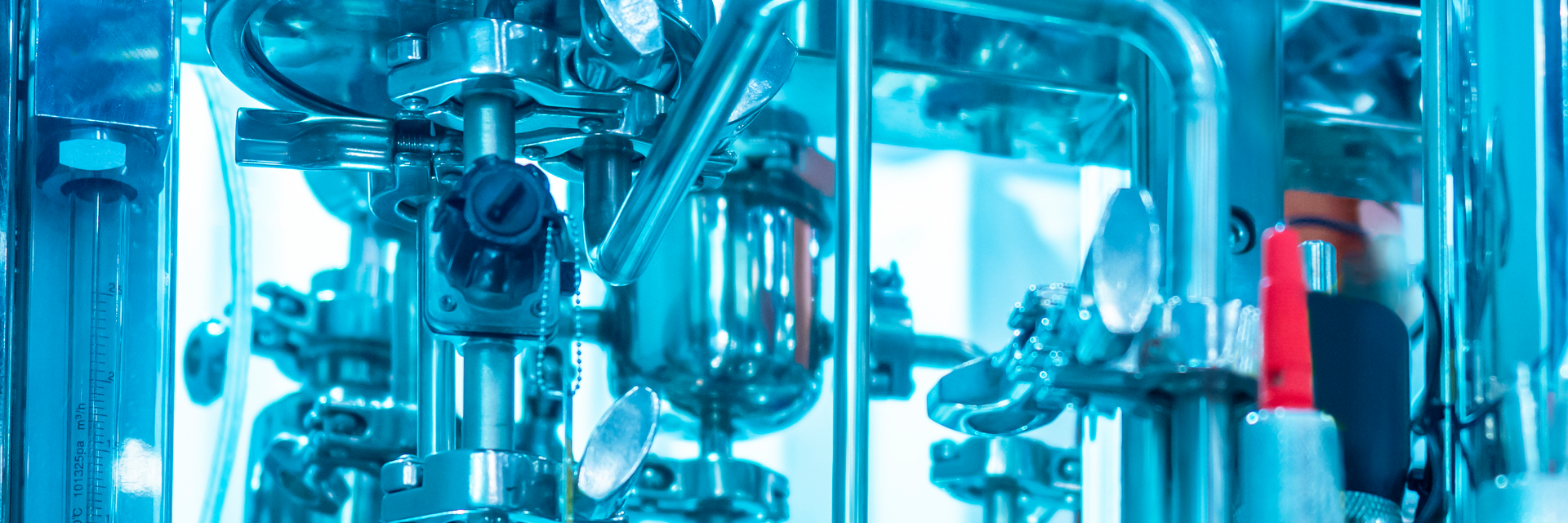
5 ways a zero-based bioreactor simplifies alternative protein production
Emerging alternative protein manufacturers and the food tech sector have had to rely on biopharma practices, which inhibit scale up with steep price tags and long production times. Here’s how zero-based equipment can help tailor those practices to achieve commercial scale.
Commercial-scale alt proteins manufacturing
Discuss zero-based equipment for your process with our experts.Manufacturing alternative proteins—which includes cultivated meat, mycelium-based meat, and precision fermentation-based proteins—using the same upstream processing equipment perfected by biopharmaceutical manufacturers to make monoclonal antibodies and other biologics, has been a pragmatic use of market-available equipment. It can shorten the time needed to test new products and scale up to commercial production. Just as in biopharma, alternative protein companies had initially focused on speed to market, which allowed them to secure additional investment and reap a first-mover benefit. However, as the industry matures, companies are now focusing more on the cost of equipment. In our 2023 Horizons: Alternative Proteins report, 56% of cultivated meat and precision fermentation protein manufacturers cite equipment and facility costs as an important cost-reduction factor.
This evolution calls into question the repurposing of biopharmaceutical equipment for food manufacturing. Biopharma equipment and facilities are expensive and designed for a heavily regulated industry where manufacturers are required to adhere to much stricter standards in the construction and operability of their equipment due to final product safety and quality standards that have been developed over time. That works when kilograms of a drug can be sold for billions of dollars. But it doesn’t make sense when producers are hoping to reach a target price for a pound of cultivated protein that is the same as, or lower, than that of traditional meat or dairy.
Alternative protein needs processing techniques and equipment that are scalable and much less expensive than the overly complex and redundant bioreactors and highly regulated conditions under which a best-selling biologic is made. It’s unnecessary and, in fact, is cost inefficient. And the issue is especially timely. Our recent report found that 82% of cultivated meat producers plan to invest in facilities to address production barriers. It’s critical that these investments are done in a cost-effective manner.
Other industries show fermentation can be done in a cost-effective way. Craft breweries have largely solved this dilemma. Yet, while there are off-the-shelf beer fermenters, they don’t offer the sterility that alternative protein manufacturers need, and they don’t offer precise control of fermentation conditions. The alternative protein industry is still waiting for something similar—a prefabricated bioreactor appropriate for the production of alternative proteins.
Using zero-based equipment design, conventional bioreactors and processing equipment can be adapted to drive down costs and schedules while maintaining regulatory compliance and user requirements. Zero-based design simplifies the fail-safe, redundant engineering that is essential in biopharma, while maintaining the sterility and control required for alternative proteins. It turns out the food technology sector is ripe for simplified processing equipment and other innovations that will bring down cost, while maintaining quality and safety.
Here, we will cover a few of the advantages of zero-based equipment to make alternative proteins and other food ingredients derived from fermentation:
- Increased speed to market
- Reduced capital costs
- Streamlined operating expenses
- Flexible and scalable processes
- Simplified integration with other process equipment
What is zero-based equipment design?
A traditional project begins with an estimated budget, often guided by that of a similar project. Instead of this approach, zero-based design starts with a budget of $0 and adds scope from there, based on what’s necessary, relevant, and in keeping with the project’s goals, including safety and flexibility. With CRB’s ONEsolution™, the total cost is derived from zero-based scope, which forces us to evaluate every expense in the budget of a proposed construction project. We used zero-based scope to plan a manufacturing facility for Tuffy’s Pet Treats, which allowed us to deliver a safe and flexible facility for $800,000 below the target value.
Applied to equipment, zero-based design adapts equipment to make it less expensive or, for a facility, sources less-expensive equipment. The design of zero-based equipment is a fit-for-purpose engineering exercise in which every expense needs to be justified. It determines the minimal technical solution that does the job, has enough features to meet most applications, and avoids the redundancy and safety measures common in the biopharma industry, without compromising on sterility or process control.
Where is zero-based equipment being used?
Zero-based design includes looking at unconventional manufacturing methods, finding non-traditional suppliers, or innovating with existing ones, and simplifying processes. The result is equipment with the right number of features adapted for the food tech sector.
Such an innovation, mass-produced for the immediate needs of most companies trying to commercialize, will have the minimum technical requirements to meet code, comply with regulations, and embrace good design practices.
A zero-based equipment design philosophy can apply to any industry, but we’re seeing great opportunities in fermentation applications. This includes using zero-based bioreactors to make cultivated meat; fermented flavorings, colors, and enzymes; pet food; and food additives. MycoTechnology is one company using fermenters for many applications.
Zero-based bioreactors can optimize cultivated meat production
Food facility inspectors are not looking for the same types and amounts of certifications required by pharma inspectors. Those regulations and certifications, while appropriate for injectable pharmaceuticals to highly immune-compromised populations, can contribute to the high costs of bioreactors for biopharma applications. But for the food and beverage industry, this scenario simply doesn’t apply. Paring down a bioreactor to the minimum requirements needed for the alternative protein industry greatly reduces production costs while maintaining safety and quality.
Zero-based promotes a clean culture, but one based on batch value. It starts with a vessel and appropriate agitation. It allows simple transfer in and out without the option for multiple feeds. The zero-base design we’re talking about is packed with all the features that a client needs to have a flexible process. A stainless-steel zero-based bioreactor can do multiple feeds, and can be cleaned and sterilized between batches. It allows fed-batch operations, perfusion, and split harvest with additional add-on equipment.


CRB led the design of JBT’s READYGo Bioreactor, delivering a zero-based equipment solution that empowers the alternative protein industry to scale production and add capacity quickly, efficiently, and reliably. The vessels are also sized for rapid deployment in the alternative proteins industry, delivering the capacity that 89% of mycelium producers and 98% of cultivated meat producers are seeking in the next 5 years, according to our Horizons: Alternative Proteins report.
The advantages of zero-based fermentation equipment
1. Speed to market
The biggest driver in the cultured meat sector is speed to market. Being able to deliver this equipment production-ready in two-thirds the time or less of conventional equipment is important to cultured meat producers.
Here’s how combining off-the-shelf equipment, offsite fabrication, and CRB’s ONEsolution delivery method greatly reduces lead time.
- Equipment is already designed and tested – It can take as long as six months to design and specify custom equipment, after which it still needs to be ordered. By choosing equipment that’s already been designed, you’re reducing cost and speeding up delivery. Additionally, computational fluid dynamics (CFD) models provide additional risk mitigation understanding there can be a higher sense of concern around any capital-intensive off-the-shelf purchases and their ability to achieve what they claim.
- Offsite fabrication – Manufactured using prefabricated components, this reduces fabrication time by as much as 40%. It also simplifies factory acceptance testing (FAT) because each part is identical and ready to go.
- ONEsolution – Integrating the work of engineers, construction managers, equipment suppliers, and our clients speeds up the design process. ONEsolution incorporates zero-based principles to evaluate and justify every expense in the budget of a proposed construction project.
2. Capital cost savings
Driving down the costs and schedule for a company is important in this competitive sector. For manufacturers to be commercially viable in the alternative protein space, the cost of a bioreactor has to be one-third of a conventional, pharma-grade bioreactor. Fortunately, reduced cost still comes with a design tailored to meet the needs of the application.
3. Lower OPEX
Operating expenses, while not reduced by the design, tend to be lower during operation and in the design of the utility equipment used to clean or power it.
- Utilities – The equipment minimizes the requirements for clean steam condensate on the agitator seal. The system is simplified so it’s easier to validate and there isn’t the continuous concern for revalidation that exists in pharma applications.
- Maintenance – Repairs and readily available parts for replacement tend to be less expensive than for novel equipment.
4. Flexible and scalable cultivated meat process
The benchtop cultures used in R&D are relatively straightforward, using small plastic tissue-culture flasks and transfers in and out of a biosafety cabinet. Scaling up to larger bioreactors, for clinical production, is a different process—they’re more than just tanks, involving a lot of piping.
Coming from biopharma, the initial design of bioreactors for alternative protein manufacturers had a lot of the attributes of the biopharma industry. Consequently, the costs were higher than what the industry needed as it scaled up toward commercial viability.
The zero-based design initiative starts with the bare minimum that is compliant with regulations and meets the user requirement with our access in the base offering. In any event, the bioreactors are feature-packed.
A range of culture volumes
The equipment for alternative proteins and other fermentation products is designed with an eye on how the process can be scaled up or out to the size or throughput of total facility needs. This also applies to utility equipment. It allows you to jump from one appropriate tank size to the next in the most cost-effective way compared to a traditional 2:1 or 5:1 scaling factor. Our research indicates most commercial-scale producers can start with a standard-sized scale-up train. Eventually, if you need to scale up further, different design parameters could be included.
Zero-based bioreactors come in a range of volumes that cover the cell culture needs of a pilot plant and the seed train of a production plant. These volumes allow you to develop your process and prove that you can produce at scale.
5. Automation and integration with other equipment
The bioreactors come with essential features that allow for fed-batch, partial harvest, and perfusion operations—without the expense of custom equipment. They are much more than agitated tanks.
Alternative protein producers will find that choosing this off-the-shelf piece of equipment versus a novel piece of equipment leads to a ripple effect on utilities, automation, integration, and manufacturing. And all the information about integration will be published. As opposed to conventional design, in which you design the equipment and automation comes at a much later phase, here the equipment comes automated. Being able to integrate it is relatively straightforward compared to conventional design.
Simplifying food production equipment helps take the pharma out of food
Innovations in zero-based equipment for food tech are well on their way. To learn more about how you can leverage zero-based equipment in your facility, contact us.





